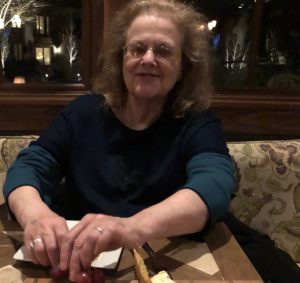 I visited my sister Pat in a memory care facility in the Boston area this past weekend. I hadn’t seen her for over a year so I was unsure of what to expect. She’d moved into this facility in July; her fourth in the past four years.It wasn’t hard to get in, the doors on the ground floor were unlocked, as was the elevator. Getting out would be the difficulty.
I visited my sister Pat in a memory care facility in the Boston area this past weekend. I hadn’t seen her for over a year so I was unsure of what to expect. She’d moved into this facility in July; her fourth in the past four years.It wasn’t hard to get in, the doors on the ground floor were unlocked, as was the elevator. Getting out would be the difficulty.
The woman at the front deck directed me to my sister’s room one floor up and I stopped at the nurses’ station. Nurse Julie remembered me from our phone conversations. Having been unable to get a phone in Pat’s room the procedure for calls was to call the facility, get transferred to the correct nurse’s station, and have the nurse find Pat to come to the phone.
Growing up, Pat and I slept in the master bedroom of our house in side-by-side twin beds with our younger sister Mary Jane in a youth bed across the room. Now, after being directed to her new room I’m shocked that her sleeping space is a white-fitted sheet cot-sized bed in the middle of two other women’s beds, with barely a path to walk beside them. Each woman has a cabinet beside her bed and across from that, a dresser with a TV on top. The television could be viewed from the bed if we removed the framed pictures of her son, her two grandchildren, and our parents and siblings currently blocking the screen. Since Pat had so recently been moved from a two-person room, I notice her few possessions were in a large laundry basket beside the dresser.
I take a deep breath to ward off feelings of claustrophobia and traveled back to images of Pat’s other spaces – first a large two-room apartment with a private bath, furnished with furniture, paintings, and art objects carefully selected from her four-bedroom home of over 40 years. I stayed there when she went in the hospital for surgery, and with her during her recuperation. Three months later her son Adam felt it necessary to move her closer to him in MA. He found a small assisted living place in Sudbury, a former orchard with an accompanying children’s day care center on the same garden-like property. Her two-room apartment was smaller than the first, but it was able to accommodate most of the furniture and art work Pat and Adam had driven in a U-haul truck from Michigan.
Pat lived at that state-of-the art facility a year and a half – until she ran out of money. When Adam selected this facility they were cooperating with the MA Medicaid assistance program but when her funds were depleted, in spite of the statement of cooperation still on their website, they declined to cooperate and she had to leave.
The third facility had well-appointed furnishings in its common areas but her space was now an L shaped studio apartment – bed in the corner, a place for her small love seat and television, a few of her framed pictures and a private bath. The grounds did not offer much opportunity to walk outside so I came from Pittsburgh last spring and took her on a girl’s road trip to explore much of the surrounding New England countryside. After a year, as her condition deteriorated she was asked to leave this facility as they did not have the staff to care for her.
Finding her in the day room I notice everyone without exception is in a wheel chair. As Pat reaches up from her wheel chair to hug me she sets off an extremely unpleasant alarm. This disruption of the peace happens when anyone attempts to stand. Alarms go off often, and for quite a length of time until two staff members come, place themselves on either side of the person, and lift them to their feet. Preventing falls seems paramount.
What tore at my heart the most however was the condition of her glasses. As she was trying to look up at me from her wheel chair I could see it was impossible for her to see through both lenses of her glasses at the same time, the frames were so bent and distorted. That became a mission for a big sister rescue.
Pat had a walker with her name on it, so I used that to take her out into the world. I learned later that she had not had a physical therapy evaluation in the three months she’d been there, and that was required to clear her to use a walker. She did fine. We went shopping for new clothes, to lunch at a lovely restaurant, and to get those glasses fixed. We arrived at the vision center a few minutes after they closed at 3 pm on that Saturday. Disappointed we continued to our favorite dress shop a few doors down, and while focusing on fashion and comfort and what’s on sale, the shop clerk said, “I can fix those glasses.” She took her jewelry tools and straightened the frames so the lenses matched up with the center of Pat’s eyes. What an amazing miracle of kindness in our screwed up world.
What acts of kindness have you experienced while taking care of someone else?

